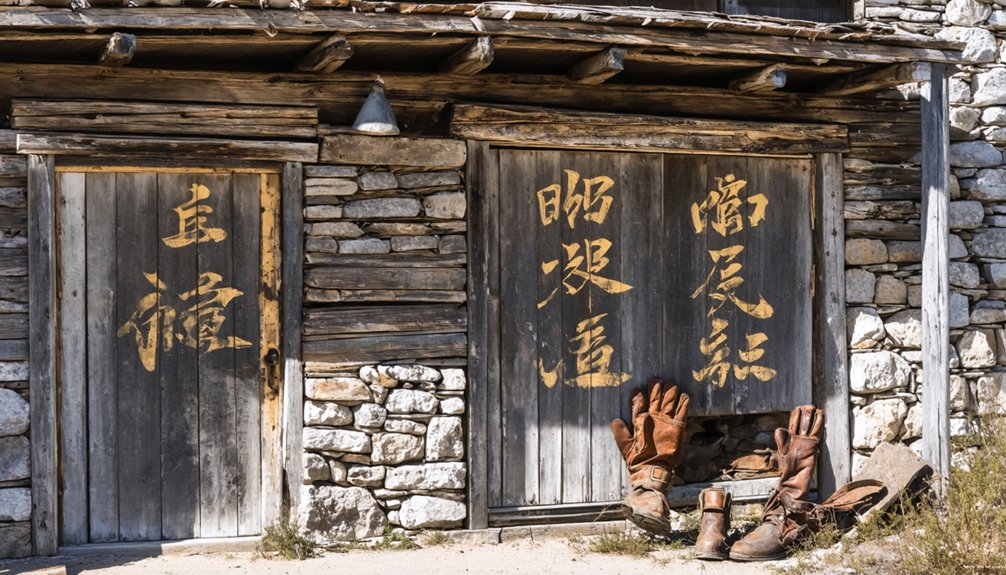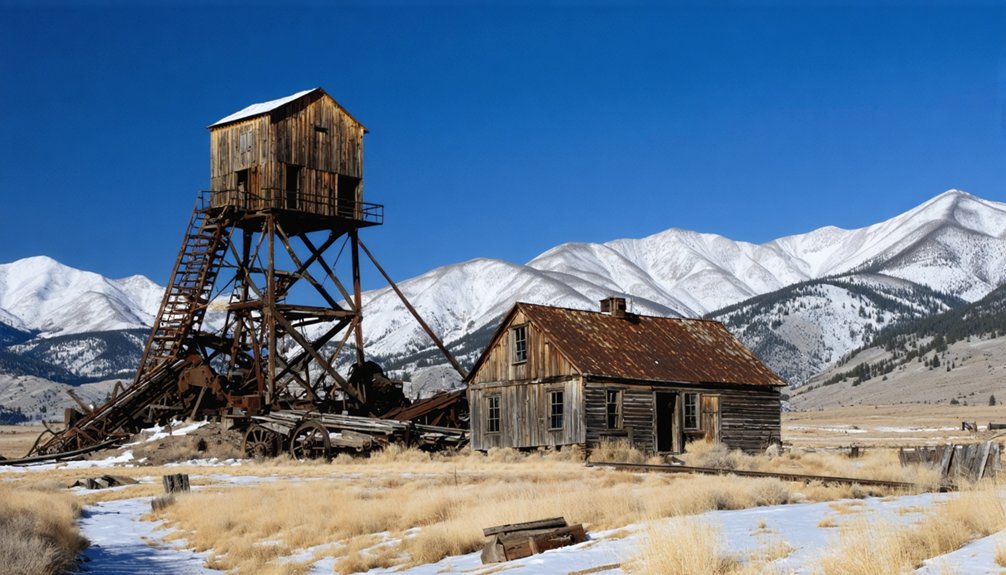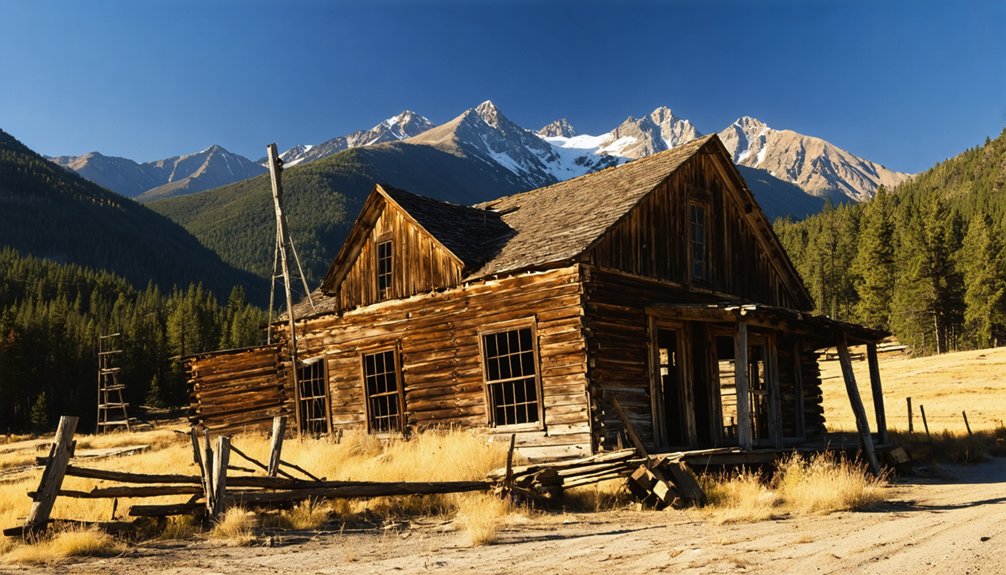You’ll find White Knob ghost town in Idaho’s White Knob Mountains, where copper’s discovery in 1879 launched a mining boom. The Empire Copper Company thrived here from 1901-1912, building blast furnaces and generating $47.5 million in cobalt production. Miners, including many Basque immigrants, lived in hillside shanties while working 10-12 hour underground shifts. Today, you can explore the preserved tram headhouse, degrading cabins, and mining equipment that tell this rich frontier story.
Key Takeaways
- White Knob ghost town features preserved mining structures including a tram headhouse and degrading cabins from its copper mining heyday.
- Located in Idaho’s White Knob Mountains, the site began as a copper mining district in 1879 and peaked in production by 1912.
- The Empire Copper Company operated successfully here, producing $47.5 million in cobalt before its eventual decline.
- Visitors can access the ghost town via rough gravel roads and explore the site through self-guided tours with informational signage.
- The site is listed on the National Register of Historic Places and remains undeveloped, offering authentic glimpses into mining heritage.
The Birth of a Mining Frontier
When copper was first discovered in Idaho’s White Knob Mountains in 1879, it sparked a mining rush that would transform the region near present-day Mackay.
You’ll find that mining innovations quickly took root as prospectors uncovered rich deposits of lead and silver in the nearby Nicholia district by 1880.
The establishment of the White Knob Mining District in 1884 marked significant economic changes, as copper and zinc deposits drew more miners to the area.
The Empire Copper Company successfully operated through a leasing system that brought stability to local mining operations.
The area’s growth accelerated when the Oregon Short Line railroad arrived in 1901, connecting the mining district to larger markets.
Mining Prosperity and Economic Peaks
The mining economy of White Knob reached its zenith in 1901 with the construction of two 125-ton blast furnaces at the Mackay smelter. You’ll find that this period marked the height of the mining boom, as the Empire Copper Co. implemented a profitable leasing system after earlier management failures.
During these peak years, you’d see anywhere from 100 to 400 miners working the rich deposits of copper, lead, silver, and zinc in the White Knob Mountains. The mine’s underground operations produced ore with 17% zinc grade in 1942.
The town’s fortunes rode the economic cycles of metal prices, with prosperity following high market values. To support the thriving operations, you’d witness the development of essential infrastructure including tramways, railroad connections, and crushing mills.
As metal prices soared, White Knob’s mining operations expanded rapidly, bringing new railways, tramways and mills to support the booming industry.
The Shay mining railroad trestle, which still stands today, serves as a symbol of this prosperous era. The bustling community featured saloons and general stores that served the mining workforce.
Life in Early White Knob
Life in early White Knob centered around your family’s daily trek from crude hillside dwellings to the bustling mine sites on Mine Hill.
You’d find comfort and community at the local Basque boarding houses, which served as cultural hubs where miners gathered after long shifts to share meals and stories.
If you were raising children in White Knob, you’d navigate the challenging terrain between makeshift homes and the town’s basic amenities, including the school and theater that provided glimpses of normalcy in this rugged mining settlement.
The Empire Mining Company established significant operations here, providing steady work for the town’s residents.
The mining operations produced an impressive $3,750,000 worth of minerals by early 1914, creating prosperity that sustained the community.
Mining Families Daily Routines
Rising before dawn, mining families in White Knob began their daily routines with urgent tasks essential for survival in this remote mountain settlement.
You’d find women stoking fires and preparing meals while miners headed to their 10-12 hour underground shifts. Daily survival meant constant work – hauling water from communal sources, baking bread, and mending mining gear.
Throughout the day, you’d see family cooperation as women managed households in crude shelters while older children helped with chores. Visitors from the Idaho Heritage Trust would later document these historic mining structures to preserve their legacy. The families lived in the shadow of White Knob Mountain, where copper was first discovered in 1901.
When evening came, families gathered in cramped quarters, sharing meals and brief moments of leisure through storytelling or music.
In winter, you’d notice even more challenges as harsh mountain conditions forced families to adapt constantly, from repairing makeshift dwellings to preserving limited food supplies.
Boarding House Social Life
Beyond daily family routines, boarding houses emerged as vibrant social hubs in White Knob during the 1920s, particularly serving single Basque miners seeking a taste of home. You’d find establishments like the Soloaga and Uresti family houses bustling with activity, where boarding house camaraderie thrived through shared stories and traditional celebrations.
After the 1902 miners’ strike, you could choose your own lodging rather than stay in company housing, leading to a boom in ethnic boarding houses. Mine operations were disrupted when labor issues reduced output during 1917-1918.
Communal meals became legendary, with some houses known for serving the valley’s finest food. You’d gather in common areas to share news, enjoy music, and maintain cultural connections. The local Mackay Mansion provided an elegant entertainment venue for visiting mining investors.
These spaces, whether behind hotels like the Custer or in structured wooden homes, provided essential stability and mutual support in an otherwise transient mining town.
Architecture and Town Development
If you’d visited White Knob during its peak mining years of 1901-1905, you’d have found a rugged settlement dominated by makeshift dwellings carved into hillsides and simple wooden cabins clustered near the mine sites.
The town’s commercial infrastructure included basic services like stores, a restaurant, boarding house, blacksmith shop, and saloons, though many residents relied on nearby Mackay for additional amenities.
Most miners lived directly on “the Hill” in temporary housing that transformed from a tent city in summer to more permanent shelter during harsh winter months, reflecting the town’s unplanned, organic development around its mining operations.
Mining Town Building Features
White Knob’s architectural landscape reflected the harsh realities of early 1900s mining life, with industrial structures dominating the town’s development.
You’ll find massive ore processing facilities, including a smelter equipped with two 125-ton blast furnaces, which anchored the town’s mining infrastructure. Scattered across Mine Hill, you’ll see remnants of wooden frame buildings and log structures that housed workers close to the mining operations.
The town’s layout adapted to the rugged terrain, with industrial buildings concentrated on lower ground while miners’ homes clung to the steep hillsides.
Essential support structures like workshops, boarding houses, and saloons dotted the limited flat areas. The Oregon Short Line railroad connection and aerial tramways created a network that kept White Knob’s mining operations flowing despite the challenging mountain environment.
Living Quarters and Stores
While miners labored in White Knob’s bustling operations, they lived in crude dwellings scattered across Mine Hill’s steep terrain, situated roughly 4 miles from Mackay’s town center.
You’ll find simple log cabins and shanties once dotted the hillsides, built from local materials with basic features like attic spaces. Today, only foundations and scattered wood remnants mark where these homes stood.
Living conditions were harsh, but the Basque boardinghouse served as the community’s heart. It’s where you’d have found single miners and families gathering for meals and social events, keeping their cultural traditions alive.
Commercial spaces were minimal – there’s little evidence of formal stores or shops. Instead, basic goods and services likely operated informally through boardinghouses and private homes.
Cultural Diversity and Social Fabric

Life in White Knob revolved around a rich tapestry of cultural diversity, anchored by a significant Basque immigrant presence from the early 1900s through mid-century.
You’d find these hardworking immigrants living near the mines in simple shanties and dugouts, while maintaining their cultural retention through vibrant boardinghouses that served as social hubs.
The town’s immigrant integration flourished through local institutions like the Methodist church, general stores, and community celebrations.
You’ll notice how the “Tons of Meat, It’s Mackay’s Treat” festival, started in 1935, brought everyone together.
While mining and sheep raising provided economic foundations, it’s the multicultural social fabric that gave White Knob its character.
Beyond its industries, White Knob’s true essence emerged from the diverse cultural threads woven through its community life.
Basque families, in particular, kept their heritage alive through language, customs, and community gatherings.
Natural Surroundings and Geography
Beyond the cultural vibrancy of White Knob’s social life stood the imposing White Knob Mountains, a rugged range in south-central Idaho west of Mackay and US Route 93.
You’ll find yourself in some of Idaho’s most dramatic terrain, where the Lost River Fault has shaped the landscape through significant seismic activity, most importantly during the 1983 Mount Borah earthquake.
The rugged terrain rises above the treeline, offering you unobstructed 360-degree views of the surrounding peaks and valleys.
You’re in the rain shadow of the Pioneer Mountains, where sagebrush dominates the drier landscape, though you’ll spot stands of limber pine and spruce in the mountain valleys.
The area’s distinct geography supported both abundant wildlife and the mining operations that once defined White Knob.
The Decline of a Mining Empire

Despite initial discoveries of lead and silver around 1880 near Mackay, White Knob’s mining operations struggled through years of mismanagement and deceit.
Early companies drained investors of $3 million without profit until Empire Copper Company took control and briefly achieved profitability.
The district faced significant technological challenges with its low-sulfur ores requiring complex mixing for efficient smelting.
Economic mismanagement compounded these difficulties, as the region couldn’t implement large-scale operations like other successful copper districts.
Though you’d see production reaching $2 million by 1912 and later generating $47.5 million in cobalt, the boom wouldn’t last.
Modern-Day Ghost Town Experience
Today’s visitors to White Knob encounter a haunting reminder of Idaho’s mining legacy.
You’ll find yourself traversing rough gravel roads to reach this remote site nestled at the base of the White Knob Mountains near Mackay, where snow-capped peaks create a dramatic backdrop for your ghost town exploration.
While there’s no formal museum, you can discover the site’s history through self-guided tours and interpretive signage.
The preserved tram headhouse, degrading cabins, and scattered mining equipment tell stories of the region’s industrial past.
Historical preservation efforts have earned White Knob a spot on the National Register of Historic Places, though you won’t find modern amenities here.
For the best experience, visit during fair weather and come prepared – this authentic ghost town remains wonderfully undeveloped, offering a pure glimpse into Idaho’s mining heritage.
Frequently Asked Questions
Are There Any Reported Ghost Sightings or Paranormal Activities in White Knob?
You won’t find documented ghost stories or paranormal investigations at this site. Despite its “ghost town” status, there’s no credible evidence of supernatural activity in White Knob’s abandoned buildings.
What Happened to the Mining Equipment and Machinery After the Town’s Abandonment?
Like scattered bones of a fallen empire, you’ll find abandoned machinery either scrapped for metal, moved to active mines, or left to rust on hillsides – with some tools repurposed by local communities.
Can Visitors Collect Mineral Specimens or Artifacts From the Site?
You shouldn’t collect minerals or artifacts here – it’s illegal since White Knob’s on the National Historic Register. The site’s preservation status requires leaving all historical materials undisturbed for future generations to study.
Were There Any Notable Crimes or Lawless Incidents During White Knob’s Peak?
You won’t find any documented crime statistics or major lawless incidents from White Knob’s mining era. Despite harsh conditions and a fluctuating population, there’s no evidence of significant law enforcement challenges during its peak.
How Safe Are the Remaining Mine Shafts and Tunnels for Exploration?
You shouldn’t explore these tunnels – they’re legally prohibited and extremely dangerous. Mine safety regulations ban entry due to risks of collapses, toxic gases, unstable explosives, and hidden vertical shafts.
References
- https://www.youtube.com/watch?v=l9n6yC2KNbQ
- https://history.idaho.gov/wp-content/uploads/0208.pdf
- https://www.hmdb.org/m.asp?m=140071
- https://www.thegoldminehotel.com/ghost-towns-and-haunted-places-in-idaho
- https://basquemuseum.eus/research/community-history-project/mackay/
- https://www.rusticlens.com/2017/09/04/white-knob-idaho-ghost-town-near-mackay-idaho/
- https://en.wikipedia.org/wiki/White_Knob
- https://www.ghosttowns.com/states/id/whiteknob.html
- https://custer.idgenweb.org/history/whiteknob.html
- https://www.mindat.org/loc-3734.html



